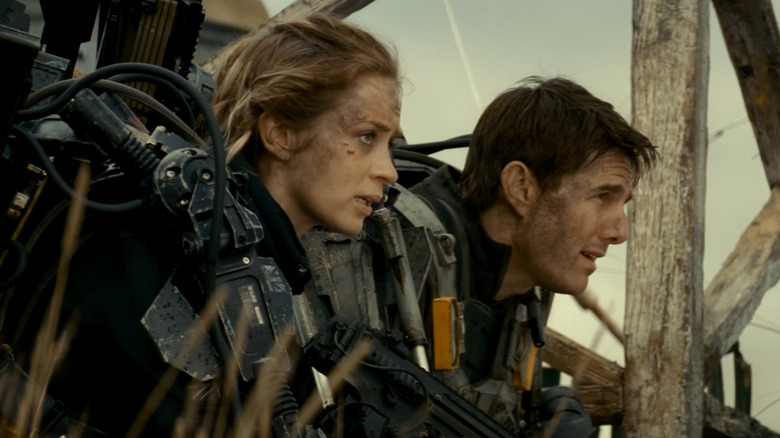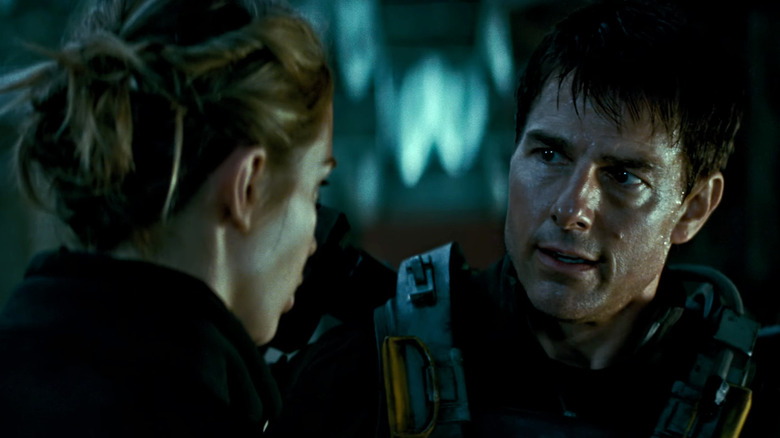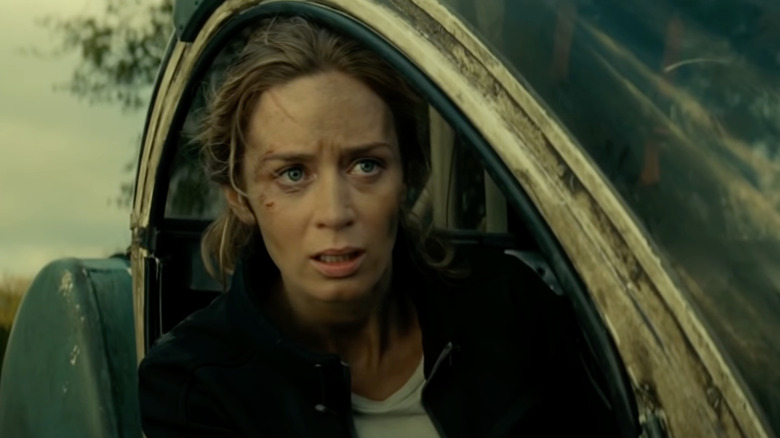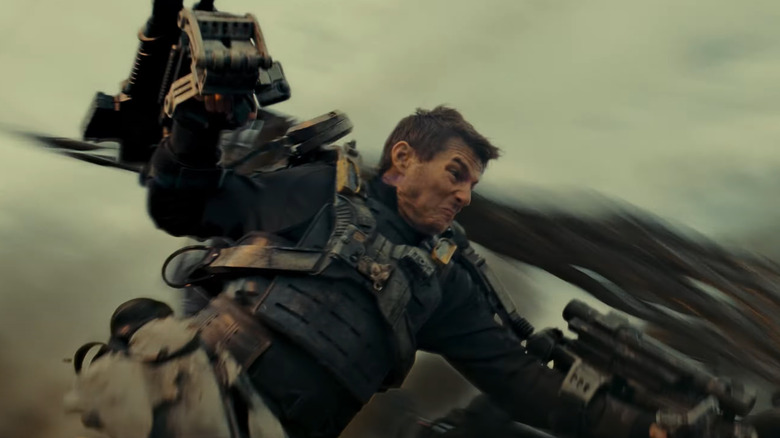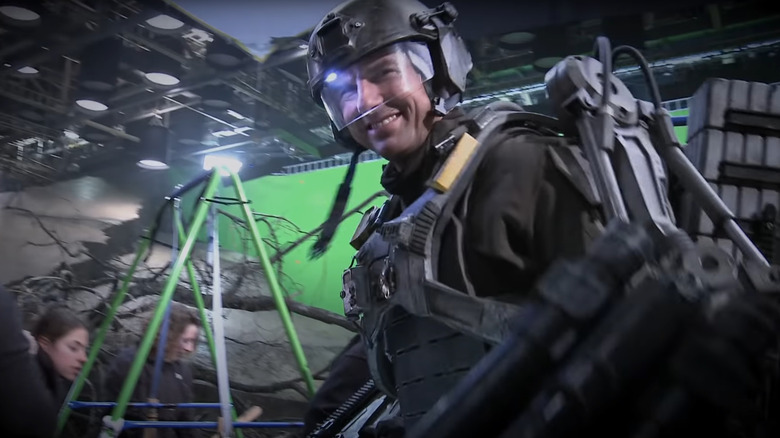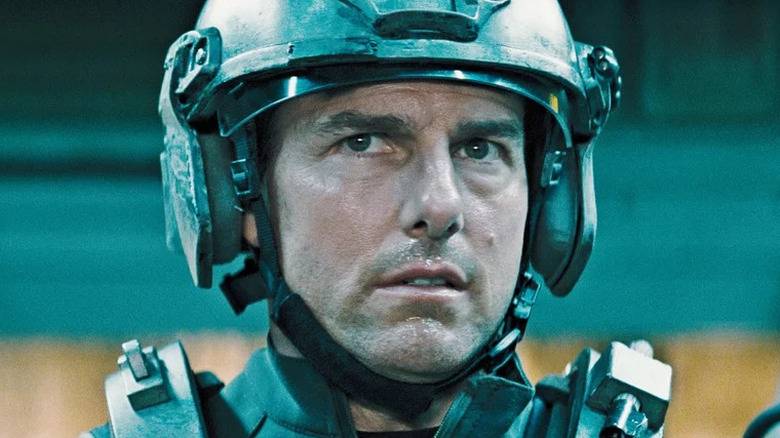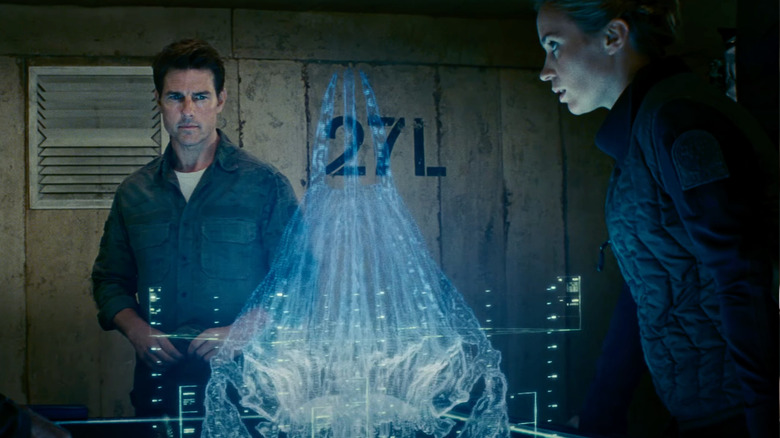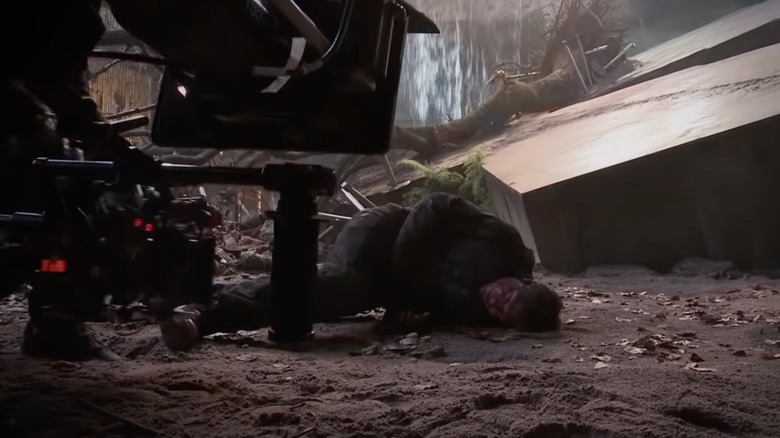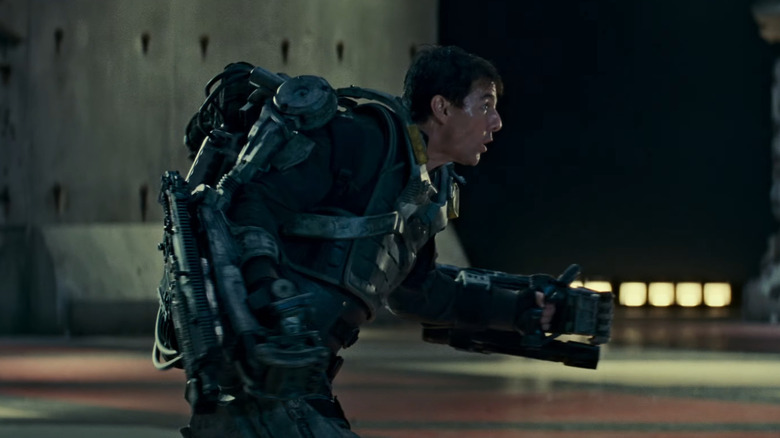What Edge Of Tomorrow Looks Like Without Special Effects
Doug Liman's epic sci-fi adventure "Edge of Tomorrow" (aka "Live Die Repeat") remains one of the great underappreciated event films of the last decade. Featuring solid performances from Tom Cruise and Emily Blunt and a sharp script from Christopher McQuarrie, Jez Butterworth, and John-Henry Butterworth, the 2014 spectacle is a compelling and even enthralling piece of entertainment.
The story, based on the novel "All You Need is Kill" by Hiroshi Sakurazaka, follows public affairs officer Major William Cage (Cruise), who inexplicably gets caught up in a war between humanity and an invading alien force. After dying on the battlefield, Cage wakes up the day before and quickly realizes he is somehow reliving the same day over and over again, resetting each time he gets killed. He then teams up with Sergeant Rita Vrataski (Blunt) to figure out the cause of his condition and the best way to utilize it against the aliens.
Naturally, with aliens and enormous battles at the story's center, special effects are required to bring Liman's vision to vivid life. While computer-generated imagery (CGI) was necessary for specific elements, notably the tentacled alien baddies, "Edge of Tomorrow" surprisingly relies on practical effects with tremendous results. Don't believe me? Read on to see what the film looked like without special effects.
Exo-suits
A key component in "Edge of Tomorrow" is the gnarly exoskeletons — or Combat Jackets — worn by military personnel during the European Mimic invasion. Ostensibly a giant weapon, these suits form around the user, allowing them to run faster, jump higher, lift heavier objects, avoid damage, and detect danger. These exoskeletons, equipped with a high-caliber rifle and a pair of rocket launchers, are the perfect counter to the alien force.
Liman's production crew designed the Combat Jacket to ensure maximum realism by "combining 275 custom-made components, plus another 150 pieces of hardware, all taken from concept to final product in 26 weeks," according to Entertainment Weekly. Since each suit weighed 85 to 135 pounds, actors didn't have to fake their performance.
"When you see the movie, the action looks authentic because we were genuinely put on wires and flipped around wearing these enormous suits," Blunt told EW.
To aid their movements, the crew hooked the actors to cables that allowed them to pull off the breathtaking action seen in the finished film. When Blunt's character launches into a spinning jump, you see a practical stunt utilizing wires, about a dozen crew members, and a little camera trickery. The struggle is by design.
"These are meant to look like military pieces of hardware, not a refined piece of engineering," costume designer Pierre Bohanna told EW. "They're brash, quickly-made pieces of equipment. So you've got to see the guys struggling in them."
Helicopter crash
Midway through "Edge of Tomorrow," Liman shifts from Cage's perspective and allows us to see his plight from Rita's point of view. The pair arrive at a barn, and she discovers that he knows intimate details about her. Eventually, he explains that she dies in every scenario they've enacted, and this is his way of trying to protect her. Enraged, Rita hops in a helicopter and attempts to fly away, but a nearby Mimic emerges, attacks, and causes the vehicle to crash into the barn. Cage leaps out of the way just in time to prevent injury, grabs a gun, and blasts the alien to bits.
Surprisingly, Liman utilizes a hefty amount of practical effects for this sequence. The special effects team constructed a replica of a Hughes 269 helicopter, which crashed through a set as Cruise frantically searched for a weapon. CGI enhanced the sequence, adding the Mimic, the helicopter blades, explosions, and debris, but a fair amount of onset destruction renders the scene more intense than it had any right to be.
Beach sequence
The Normandy invasion, or "Beach Sequence," relies on a combination of practical and computer-generated effects. According to The LA Times, the sequence was meant to take up only two weeks of filming but lasted nearly three months due to Liman's improvisational filmmaking style. The production built an actual beach at Warner Bros. Studios in Leavesden near London, and the shoot was so rigorous the locale earned the nickname "the B****" from the cast and crew.
The production used real explosions, wires, and rigs that allowed the stars to flip about in their exoskeletons. Blunt, in a bid to keep up with Cruise's stunt work, almost broke her nose, according to an interview with Delaware Online, and permanently damaged her thumb. Massive green screens made the sequence appear like a large army was storming the beachhead.
Check out the behind-the-scenes footage for "Edge of Tomorrow," and you'll be surprised at the spectacular scope of the production. The scene resembles something from "Saving Private Ryan" rather than a sci-fi action film.
Car Charge
A particularly fantastic scene in "Edge of Tomorrow" sees Cage and Rita escape the beach invasion and flee from attacking Mimics on a nearby street. At one point, Cage leaps at a car and knocks it out of the way using his exoskeleton. On film, our heroes look like super soldiers running at full speed, leaping into the air, and lifting heavy objects without much effort. As captured in a behind-the-scenes video via ScreenSlam, it seems different due to the assortment of wires and cranes connected to the actors and props.
When Cage hits the car, a cable attached to the wheel pulls the vehicle back while fake glass launches into the air to make the impact more realistic. The timing has to be perfect. Too soon, the motion would look artificial; too late, and Tom Cruise would bounce right off the car. Thankfully, the production team nailed the beat and produced a relatively astonishing practical effect that looks great on screen.
Finale
In the film's grand finale, Cage leads a motley crew — dubbed the J-Squad — against the aliens' base of operations beneath Paris, specifically in the Louvre. Flooded and abandoned, the location is accessible only by a heavily armed gunship. Cage operates a machine gun while his teammates do their best to commandeer the craft against waves of enemies. Imagine a video game, except with a smidge more gravitas.
The production crew built part of a gunship capable of simulating movement on a massive set surrounded by a green screen to achieve this action beat. Live-action elements, including water splashes, were shot onstage while CGI created the background imagery. VFX Supervisor Nick Davis and his team photographed buildings and textures in Paris, which they used to create CG models. Per the special effects department Framestore's website, "miles and miles of a digitally-built, water-filled, smoke and fire enclosed city" were designed.
Lightning, fog, and night effects took a lot of work to render. Still, Framestore used a program called Arnold and an in-house simulator called fLush to pull off the incredible feat, resulting in a high-octane third-act that caps "Edge of Tomorrow" on a thrilling, visually impressive note.
Hologram table
"Edge of Tomorrow" contains several visual effects that you probably wouldn't realize were visual effects unless someone pointed them out to you. Notably, a scene in which Cage and Rita stare at a hologram is rather sneaky in its execution. The hologram imagery is obviously fake, but according to a VFX breakdown video by Prime Focus, the entire room surrounding our heroes is also artificial, including the lamps, bookshelf, and gadgets in the background.
Digital artists created several artificial environments — ironic considering the lengths the production went to ensure absolute realism in the big action sequences. None of the green screen work detracts like, say, "Star Wars: Episode II — Attack of the Clones," but if you look hard enough, you'll notice the slightly artificial look of specific sequences.
"What we've been able to do in the background on 'Edge of Tomorrow' is start advancing the use of LiDAR for certain environments," said Senior Stereo Supervisor Richard Baker, "and that could be because they're quite geometrical environments or there's lots of those shots in that room ... it's fairly easy to track and build a simple model yourself."
Cruise flies out of gunship
During the climax, Cage and his crew zip across the flooded streets of Paris aboard a gunship, blasting hundreds of Mimics to pieces with their vast array of weapons. Eventually, the aliens overrun our heroes, destroying the gunship and sending it smashing into the Louvre while Cage clings to a machine gun mounted on the side door. He lets go and flies into the air, landing hard inside the abandoned museum.
According to Nick Davis, the VFX team had to create a "handoff" between a computer-generated image of Tom Cruise and the actor himself. Cruise performed a real stunt on a set and rolled about 20 feet down a structure. So, the first part of him flying out of the gunship is a CGI model that seamlessly morphs into live action. Glass simulations provided realistic debris, along with explosions and such, resulting in a magnificent piece of action that blends the best of both worlds in terms of practical and CGI effects.
Military Base
A large chunk of "Edge of Tomorrow" occurs at Heathrow Airport, now a military base where Cage awakens daily to Master Sergeant Farell (Bill Paxton) and his platoon. Filming comprised mainly of sets at Warner Bros. Leavesden Studios in London that recreated portions of Heathrow, merged with composite shots of the actual location.
More impressively, wider shots of Heathrow required special effects artists to remove the large airplane stationed on the tarmac and replace it with various tents, gunships, and soldiers. As you can see in a video from Rodeo FX's YouTube channel, the gunships are fake, but it's hard to tell what's real and what's artificial in this sequence. There's even a stunning night shot of a soldier overlooking the base that likewise required a hefty amount of digital compositing. In the film, we see a massive military compound stretching into darkness. In reality, the soldier looks out over Leavesden Studios, with a series of tan soundstages lingering on the horizon.
Training Sequence
The gist of "Edge of Tomorrow" is that Cage has been a cowardly public affairs officer, attempting to flee when General Brigham (Brendan Gleeson) assigns him to the front lines. Consequently, he's placed in J-Squad and forced to participate in humankind's last stand against the Mimics. During the battle, he destroys a blue Mimic, somehow absorbs its power, and winds up in a time loop. The aliens can reset the day, which is how they gain the upper hand against their enemies.
Armed with this newfound gift, Cage seeks out Rita, who likewise enjoyed the time loop power earlier in the war, but has since lost it. Rita encourages Cage to practice until he becomes a one-man wrecking crew capable of wiping out hoards of alien baddies. Training involves darting around an arena, evading a claw-like machine designed to move like a Mimic. Director Doug Liman presents these thrilling (and sporadically funny) sequences as montages, during which we watch Cage die countless times before finally perfecting his fighting technique.
On set, Tom Cruise could be seen darting around a giant room on wires, sans the killer robotic claw. Visual effects artists added his artificial foe in post-production. An incredible moment sees Cage cut the claw in two and slam it against a wall. Cruise plunged into a green mat, which was later edited out in post-production to achieve the shot. Simple, but effective.
Aliens
Of course, no alien invasion movie is complete without, well, the aliens. "Edge of Tomorrow" doesn't disappoint, presenting scary-looking extraterrestrials comprised almost entirely of sharp, whirling tentacles. As the YouTube channel CGY explains, these tentacles create a single entity and allow the aliens to move kinetically, producing new limbs on the fly depending on their stance. Their unpredictable nature makes them a worthy foe for Cage and Rita, and more menacing than your average alien species.
"The only way you can outmaneuver this rapid enemy is to know what's coming in the future," notes the narrator behind CGY.
While a cool story gimmick, these aliens nonetheless presented quite the challenge for animators accustomed to solid objects designed around digital rigs. Thankfully, artist Dan Sheerin created a tool that allows animators to focus on the central core tentacle. The surrounding tentacles would adapt and move with the core tentacle. Animators could also increase the size of the tentacles or add more if the situation called for it.
Animators had animators kick up sand and debris whenever possible to mesh the aliens further within the live-action environment. Doing so gave the CGI effects weight and turned what could have been a silly piece of animation into a genuine threat.
